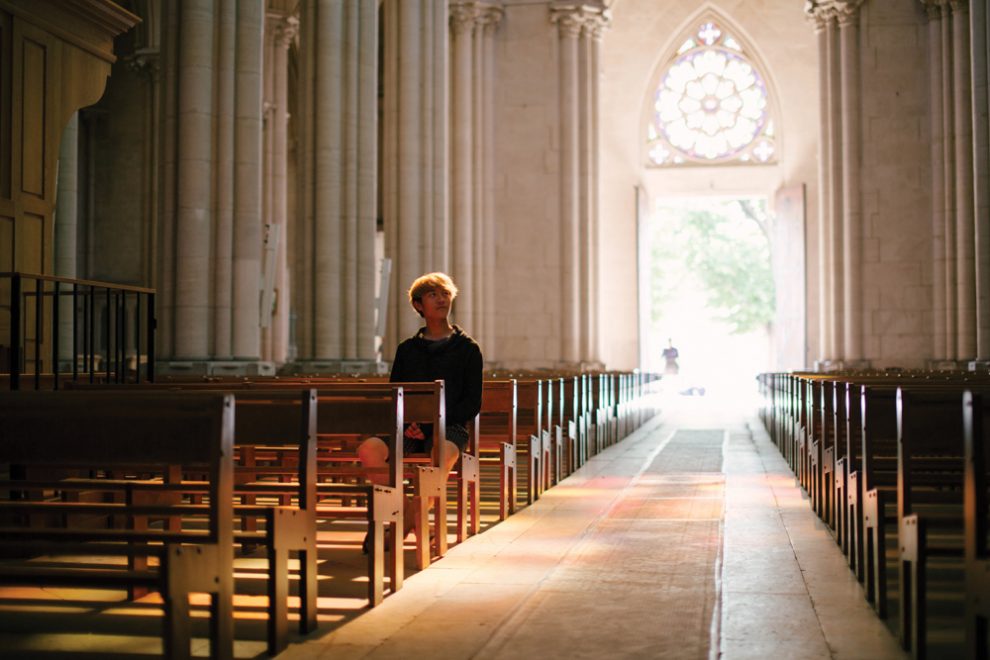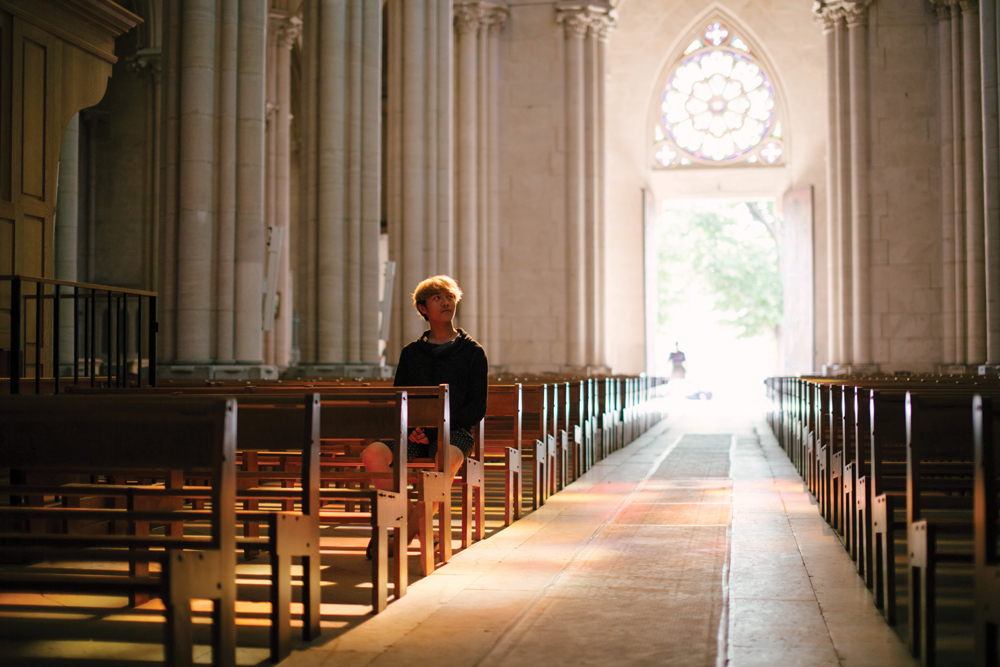This is part of a series of two essays on how to make a successful pilgrimage. You can read the other part, on eight practices of a good pilgrimage, here.
There are many ways to practice pilgrimage. You can journey far away to a sacred site, but there are also options within reach of a walk or drive from home, or even within your own imagination. Keep in mind these three essential aspects to create your own pilgrimage experience:
- Begin with an intention and prayer or blessing for this time.
- Stay open to the ways God might break in through the unexpected.
- When you return, spend time in reflection on how this experience has touched you. What new discoveries or invitations did you hear?
Walking is a wonderful way to get out of our heads and into our bodies. If mobility issues prevent this, know that imagining yourself walking to each suggested site can have the same impact. God is present to us in whatever ways we are able to receive the sacred.
Make a local pilgrimage
Chances are you live near a church or perhaps even several churches. You could choose to make a pilgrimage to your local cathedral. Using the three essential aspects, make it a sacred experience by blessing the journey there, paying attention for divine whispers along the way, and then reflecting when you return home. You might look up the church calendar to see if there is an upcoming feast day that feels especially appropriate for your journey and let that shape your prayer.
In a more urban area, plan a walking pilgrimage from one church to another. Research the churches and map out a route. Look up the various saints they are dedicated to and write a note for each of them. Offer a prayer to each saint as you make each stop. Spend 15 minutes in silence at each of the churches. Listen for what is offered to you. Remember that what can feel like interruptions or disruptions to your plans may contain the sparks of an encounter with the divine.
If you live in a rural area, still try this suggestion out, but you may need to drive between sites. Try keeping the car radio off to maintain an atmosphere of quiet reflection.
Begin your pilgrimage by reading the Road to Emmaus (Luke 24:13–35) as a blessing for this time. Listen along the way for how the holy is being revealed to you.
Make an ancestral pilgrimage
One of my favorite forms of pilgrimage is to journey to ancestral places and experience the landscape of those from my bloodline who traveled the earth before I did. However, sometimes these places are far away and require a lot of time and expense to reach.
If you live near a family cemetery, visit graves of loved ones who have passed away with the intention of making it a pilgrimage. Hold the image of the communion of saints and the Scripture image of being “surrounded by so great a cloud of witnesses” (Hebrews 12:1) as you make this journey. Feel yourself surrounded by the love of thousands who have come before you. Offer gratitude for all the ways they endured so that you might live. You could choose to make this pilgrimage during November, which is the month of remembrance of the dead, or on the anniversary of an ancestor’s birth or death.
If you have no ancestral connections close by, visit the local cemetery anyway. Pray for the people there and their families. Feel their connection to this place where you live and all the ways they may have contributed to making it the community that it is.
Make a nature pilgrimage
You might choose to make a pilgrimage to a nearby place in nature. This could be a local park that you love or even your backyard. Locate the closest forest, river, seashore, or mountain, remembering all of the holy landscapes in Scripture such as the Jordan River, the Sea of Galilee, Mount Horeb, or Mount Sinai.
Begin your pilgrimage by reading Psalm 104 and asking for the clarity to hear all of creation joining in an ongoing hymn of praise. As you walk let this be a time of contemplative listening for the more-than-human voices that surround you. Spend time with things that call to you along the way, whether a pinecone in your path, a smooth stone, moss on the trees, or a flower growing. Pay attention to the birds and animals that make this place their home, and call to mind the desert and Celtic saints who saw intimacy with animals as a special sign of holiness. Find a quiet place on your journey to sit for a time in silence and simply receive the gifts being offered to you.
Make a memory pilgrimage
This invitation is to make a pilgrimage through your memories and can be done sitting or lying down at home. The practice is inspired by St. Ignatius of Loyola’s Examen. Spend time in preparation by looking through old photos. Begin by reading Luke 2:19, where it says, “Mary treasured all these words and pondered them in her heart.” This is a pilgrimage of pondering.
Then find a quiet space, slow down your breathing, and drop inward into your imagination. Reflect back on your life and imagine that you are walking through each decade as if on a physical pilgrimage. Honor the journeys you have made. Pay attention to those moments of grace and ease when you felt a profound sense of consolation and love in your life. Let each God-kissed moment rise up, and spend time savoring it and offering a prayer of gratitude for it.
Then shift your awareness and walk through your memories again. This time pay attention to those moments of challenge and discomfort, perhaps even desolation. Let each moment rise up, and honor its role as part of your life story. See if there is anyone you would like to forgive for this experience, including yourself. Ask for God’s companionship in this journey of tenderness and remembering.
To complete the experience, bring your awareness back to the present moment and notice what you have discovered about yourself by remembering these times of both grace and challenge. Take some time to name the gifts of this pilgrimage of memory.
Make a friendship pilgrimage
Choose three friends to visit and schedule time with them, either all in one or three days in a row. Let this be a time of reflection on the gift of friendship in your life and all the ways friends of various kinds have supported you over the years. Consider bringing each of these friends a small gift that symbolizes how they enrich your life or that represents a special shared memory. Spend time together talking about the pilgrimage of each of your lives and how you have become woven together through time. Ask for support and prayer in a situation of your life and ask how you can support your friend as well.
Begin your time of pilgrimage by reading the story of the visitation (Luke 1:39–45), when Mary goes to see her cousin Elizabeth, or the story of David and Jonathan’s friendship (1 Sam. 18:1–4). Ask that your time with friends be blessed as a journey of the heart and that you might make new discoveries together about how God is calling you to be in support of one another.
Peregrinatio
The ancient Irish monks had a very unique approach to pilgrimage. They would set out on a journey for Christ, often by boat without oar or rudder, and let the currents of divine love carry them to the place of their resurrection. This is the place where their gifts and the needs of the community came together and they were able to serve fruitfully.
Instead of a literal journey by boat, you can work with the spirit of this pilgrimage experience by going for a contemplative walk without destination. Begin your pilgrimage by reading the story of Abraham and Sarah being called to leave their homeland in search of a new country (Gen. 12:1–2). Bless this time and release any desire for a goal or outcome. Take some deep breaths to center yourself and see where your feet take you. You aren’t trying to get anywhere, just to be present moment by moment to the call of the Spirit. See where your attention is drawn, pause often, and linger.
Cultivating this as a regular practice helps us to open up to peregrinatio in our daily lives when we are called to release our grasp on the life we think we need and open to the sacred possibilities being offered to us.
Life as pilgrimage
Life itself offers up many opportunities to embark on a pilgrimage journey. Sometimes these are events that don’t feel very welcome in our lives, such as illness or loss of a job or a relationship. When something challenging arises in your life, embrace the perspective of a pilgrim as a way of meeting it in a new way.
Begin your reflection by reading from the Book of Job 38:4–7, which begins with God’s question to Job, “Where were you when I laid the earth’s foundation?” and ends with God’s laying of the cornerstone “while the morning stars sang together and all the angels shouted for joy.” Taking a pilgrim’s perspective means that in the midst of struggle we search for ways to see how we might be stretched open to new images of God. We might discover the divine abiding with us in ways we hadn’t considered before, through the presence of friends, family members, or companion animals, through silence and meditation, or through being called to pare down your life commitments.
This article also appears in the July 2018 issue of U.S. Catholic (Vol. 83, No. 7, pages 12–17).



















Add comment